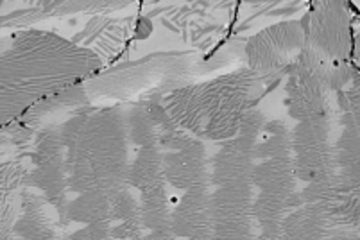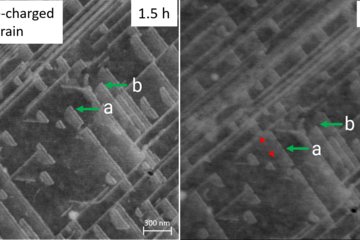All genres
621.
Talk
New approaches for in-situ nanoindentation of hydrogen charged alloys: insights on bcc FeCr alloys. DPG Spring Meeting of the Condensed Matter Section, Berlin, Germany (2018)
622.
Talk
Hydrogen embrittlement of tungsten due to deuterium plasma exposure: insights from nanoindentation. European Mechanics and Materials Conference (EMMC-16), Nantes, France (2018)
623.
Talk
Hydrogen embrittlement of tungsten due to deuterium plasma exposure: insights from nanoindentation. DPG-Frühjahrstagung 2018, Berlin, Germany (2018)
624.
Talk
Room temperature carbon redistribution in Fe–Ni–C martensite. TMS 2018 Annual Meeting & Exhibition, Phoenix, AZ, USA (2018)
625.
Talk
Direct observation of novel structures and transitions in Cu [111] tilt grain boundaries. DPG Tagung 2018, Berlin, Germany (2018)
626.
Talk
Observation of dislocation interactions with an asymm. GB by high frame-rate in situ TEM. Frühjahrstagung der DPG, Berlin, Germany (2018)
627.
Talk
Mo2BC thin films - a material system combining hardness and ductility? 5th European Conference in Nanofilms ECNF2018, Cranfield, UK (2018)
628.
Talk
Advanced TEM/STEM – a powerful tool to guide materials design. Inauguration Symposium, Institut für Metallphysik, Rheinisch-Westfälische Universität Münster, Münster, Germany (2018)
629.
Talk
“Mechanical microscopy”: Resolving the mechanical behavior and underlying mechanisms of materials with high spatial resolution. The 18th Israel Materials Engineering Conference (IMEC-18), Dead Sea, Israel (2018)
630.
Talk
Differences in dislocation source activation stress in the grain interior and at twin boundaries using nanoindentation. Nanobruecken 2018, Erlangen, Germany (2018)
631.
Talk
Dislocation – grain boundary interactions: Insights and challenges from micromechanical testing. 3rd Schöntal Symposium on Dislocation- based Plasticity (DFG Forschergruppe FOR 1650), Schöntal, Germany (2018)
632.
Talk
Towards ultra-strong alloys: thermal stability and diffusion kinetics of thin films by in-situ TEM. CALPHAD XLVII Conference, International Conference on Computer Coupling of Phase Diagrams and Thermochemistry, Querétaro, Mexico (2018)
633.
Talk
First results on phase stability, microstructure and thermomechanical behavior of CrFeCoNi thin films. Seminar at Eric Schmid Institute, Leoben, Austria (2018)
634.
Talk
Composition Dependence of Hardness and Strength of Cubic and Hexagonal NbCo2 Laves Phases. DGM Fachausschuss Intermetallische Phasen (FA‐IP), Max-Planck-Institut für Eisenforschung GmbH, Düsseldorf, Germany (2018)
635.
Talk
Combining high strength and moderate ductility in a novel ceramic coating: A combined ab initio and micromechanical study on Mo2BC. Conference on Electronic and Advanced Materials, EAM 2018, Orlando, FL, USA (2018)
636.
Talk
Aktuelle Einblicke in den Nanokosmos von Werkstoffen. Physikalisches Kolloquium, Bergische Universität Wuppertal, Wuppertal, Germany (2017)
637.
Talk
Dislocation interaction and twinning-induced plasticity in face-centered cubic Fe–Mn–C micro-pillars. MRS Fall Meeting , Boston, MA, USA (2017)
638.
Talk
Dislocation interaction and twinning-induced plasticity in face-centered cubic Fe–Mn–C micro-pillars. MECANO General Meeting, Toulouse, France (2017)
639.
Talk
Where does the carbon atom go in steel? – Insights gained by correlative transmission electron microscopy and atom probe tomography. International Symposium on Steel Science 2017, Kyoto, Japan (2017)
640.
Talk
Quantifying dislocation slip transfer by in situ micromechanics. MRS Fall Meeting 2017, Boston, MA, USA (2017)











